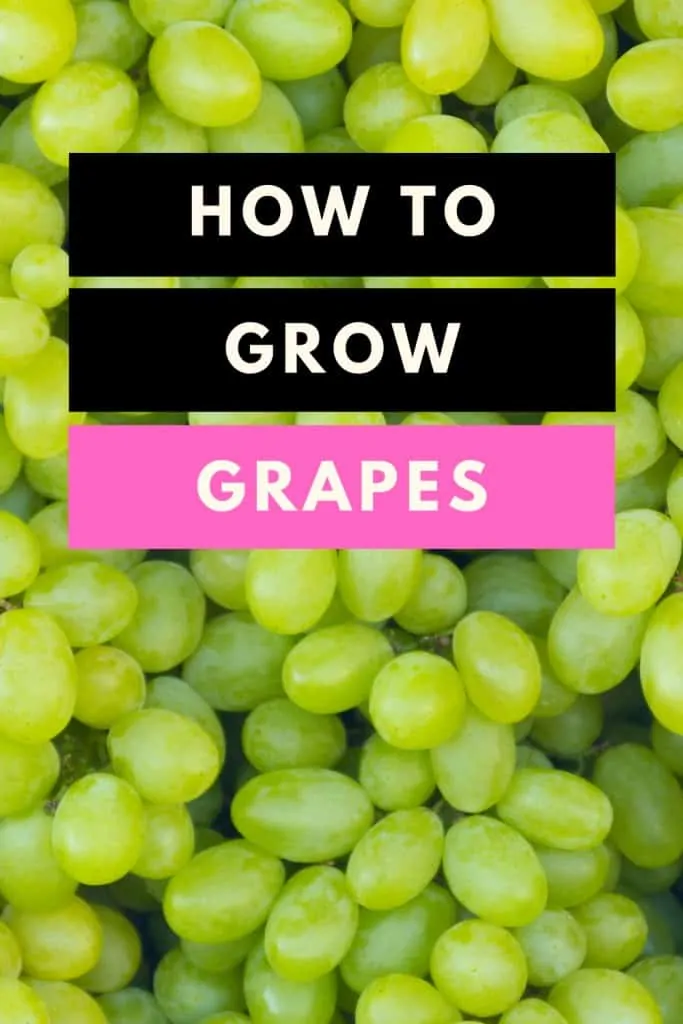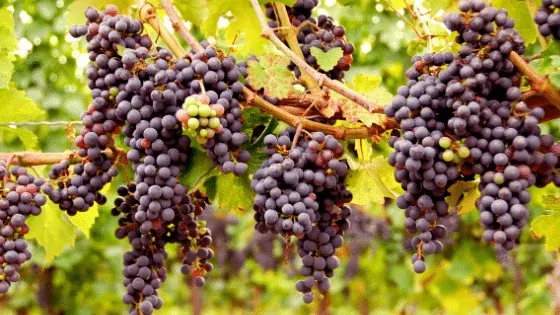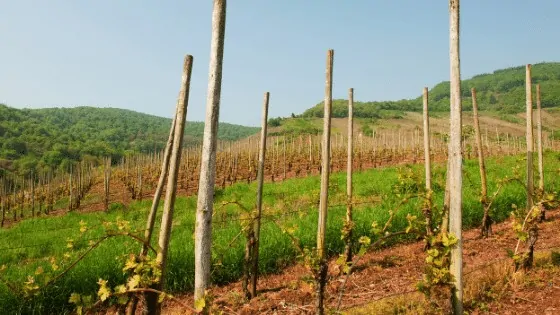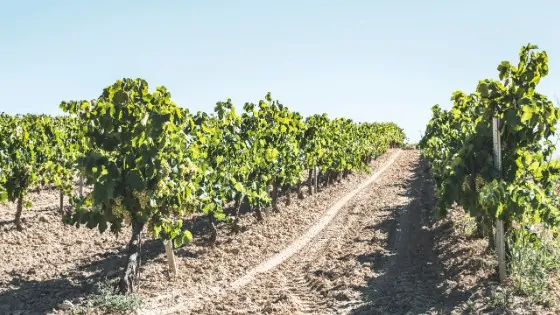Grapes have been growing for thousands of years. This lusciously juicy fruit not only bursts with fresh flavors but lends your home garden a dazzling look with its chunky bunches hanging around.
In this article, I will go into the gardening basics of growing grapes.
Table of Contents
How to Grow Grapes

How to grow grapes
Takeaways How To Grow Grapes
| Where to plant grapes | Regions with temperatures between 59-104 degrees Fahrenheit (15-40 degrees Celsius) that have mild winters, slight humidity, and a controlled amount of annual rainfall. |
| The right spot to grow grapes | A site that receives full sun |
| Soil pH for grapes | 5.5 – 7.0 |
| Soil | Sandy loam, clay loam, and even a well-drained silt loam |
| How to plant grapes | Distance of 6-10 feet between each grapevine |
| Fertilizer | High in nitrogen. Fertilize the entire soil bed |
| Watering | Water sparingly using a drip system |
| Support | Use a trellis |
| Pruning | Prune old cranes |
| Harvest | Late summer and early fall |
1. Where to plant grapes
Before you proceed with growing grapes, it is important that you understand the climatic conditions grapevines thrive in. Generally, grapes like hot and dry climates, which is why early spring is considered to be the ideal time for planting grapevines.
Any regions that experience temperatures between 59-104 degrees Fahrenheit (15-40 degrees Celsius) are best for growing grapes. In addition, mild winters, slight humidity, and a controlled amount of annual rainfall are conditions required by grapes.
If you do not live in an area matching these criteria, then there are fairly high chance that grapes won’t grow well in your garden.

Lucious grapes growing on a vine. Grapes grow best in a temperate climate.
2. The right spot to grow grapes: Soil
When deciding where to plant, you must pick a site that receives full sun. If your garden doesn’t have a spot with full sunlight, then ensure that during the morning hours, your garden gets enough sunlight.
If there is a slight shade during the noon hours, then it won’t affect the growth, assuming that the grape plantation will receive an ample amount of sunlight earlier in the day.

Planting grapes requires good soil
The soil will provide essential nutrients to the grapevine for growth, which is why well-draining soil is a necessity.
The soil needs to be deep and loose as well, ensuring good air circulation. Grapes can withstand a variety of soils and thus accommodate a wide range of soil conditions. But you must make an informed choice based on these factors:
- Be sure to conduct a pH test using a commercial kit before you formally begin planting. Grapes prefer a pH range of anywhere between 5.5 – 7.0. In case the soil pH is tested to fall outside the scale, use an acidic or alkaline solution to alter the pH accordingly.
- To check whether the soil drainage is feasible enough for growing grapes, it is recommended that you dig an equally dimensioned 20-30 cm deep hole and fill it with water. Once it has drained for an hour, refill the hole and allow the water to stand. For the next 24 hours, observe how the water has drained, if it drains within the time span, then you are good to go with grapevines. But the soil should not feel too dry, it must retain some moisture.
- For soil types, you can go towards sandy loam, clay loam, and even a well-drained silt loam. The soil should contain a healthy amount of organic matter to meet nutritional needs.
- Lastly, you must know that grapevine roots will grow about 1-2 meters when measured from the base. Therefore, when you plant a grapevine, you will have to plant them at a distance of 2.5 meters. So, choose the planting site accordingly.
Now that you know where to grow grapes we are moving on and discussing how to plant grapes. It wouldn’t be a how to grow grapes guide if we wouldn’t go into that topic as well as planting grapes the right way is key.
3. How to plant grapes
Before you plant bare-root grapevines, you must soak the roots in water for around 3-4 hours. Once thoroughly soaked and ready to be planted, make sure you remove all the canes except the ones that are vigorous.
It is recommended that there is a distance of 6-10 feet between each grapevine. For each vine, dig a hole that is both, 12 inches wide and 12 inches deep. Then fill it into about 4 inches with topsoil.
Now you can trim off roots that are longer than the normal length or are broken. Then set the vines into holes larger and deeper than the nursery they have grown in.
This will allow the root system to expand. Now you will have to cover the roots with soil completely. Grapevines are to be watered at the time of planting.
It is important that you don’t mulch the soil unnecessarily. For grapes, mulching is not always recommended as a best practice since it cools down the soil temperature in summer. Grapevines prefer warmer soil for healthy growth.
4. How to grow grapes: Fertilizing and Weeding
The early years are about plant growth, so you can be generous with the application of high nitrogen fertilizers but only in a controlled amount. After the plantation has matured, you only need to grow grapes and not the foliage around.
So, fertilize as per need only; when either the soil pH has shown nutrient deficiency or plants are observed to progress with stunted growth. However, at times when grapevines are following vigorous growth, then the soil needs a nutrient boost each year.
And when you fertilize grapevines that have matured, make sure that you fertilize the entire soil bed, since roots tend to spread over 6 feet across. Fertilizing at the base only won’t benefit the growth of grapes much.
The growth of grass and other plants must be prevented under the grapevines. This will help the soil heat up faster during spring, and this desirable soil temperature will facilitate the growth of grapes.
But if you allow grass to grow under vines, this will bring the soil temperature down, delaying the growth of grapes in springtime.
5. Watering
Grapevines are not a fan of heavy rain showers or constant watering. After you have watered them for the first time, it is recommended that you bring down the water supply to a minimum level.
Only water around the roots as this will allow quick absorption. Watering all over the soil bed will instead allow the sun to evaporate excess water immediately.
If you live in a region that experiences little or no rainfall, we would like to suggest in this guide that you arrange a drip system directly connected to the roots. This will ensure a continuous supply of water to the roots when needed in small amounts.
6. Use a Trellis

A trellis for grapes is a must
Once the grapevine has started to grow, it’s time to build a trellis. A trellis is a support for your grape plant, allowing it to climb across in a natural way.
But do remember that this part of growing grapes can get a little tiresome as you will be patient while teaching your grapevine to follow the trellis.
7. Pruning Grapes
When it comes to pruning grapevines, it is important that all rules and details are followed precisely. Homeowners often get confused during the pruning process.
The fruit production of grapes is through shoots that grow off of canes. If you do not prune, then you will end up having too many old canes, leading to fewer grapes.
This is why you must practice pruning so that your grapevines are not home to a tangled network of stems, affecting fruit production.
Vines tend to overproduce grapes. But, in this scenario, excessive production is deemed to be unfavorable and needs to be considered when thinking about how to grow grapes.
You can avoid this by thinning out the flower clusters that don’t look healthy enough to proceed with growth. And any fruit clusters that have been developing poorly can also be removed during the pruning process.
Late winters are considered to be best for pruning, this is because the plant is still dormant. For the first year, it is important that you focus on maintaining a strong root system. Planting should be done in spring, and then you can begin pruning around March.
In the first year, you will have to prune away all the sprouts shooting up from the ground. Only the ones that are healthy and strong must remain.
Select 3-4 good stems and let them develop. Train these stems on wire support. Then you will have to wait until the first winter. Now, in the second year, train these canes along a trellis or any fence once they are long enough.
When the second fall season hits, you will have to prune off about 60-70% of the plantation, and you will be left with just the main trunk and a few strong canes.
In spring, the canes will eventually be a year old, making them mature enough to sprout the necessary growth in order to develop grapes. With time, you can continue to prune branches that have already produced a good amount of fruit.
To learn more about pruning and how to grow grapes, visit Almanac’s guide to pruning grapevines on trellis and stakes.
8. Harvesting Grapes
When it comes to harvesting, the most-practiced way to check the ripeness is to pick a few and treat yourself to a taste test. The preferable taste falls between a spectrum of sweet and tart.

Taste your grapes before you harvest them
Several grape varieties tend to transition into a different color before they are even mature. So, it is not a wise idea to keep the color change as an indication of ripeness.
However, if grapes aren’t ripening, then you can try pinching back the foliage in some parts and allowing the sunlight to flow in the soil directly.
To harvest, you may begin in late summer and early fall. If you notice that the grapes are,
- bursting with juices
- fully flavored to your liking
- has a rich color
- the skin is firm
- the flesh does not easily crush when poked
- tightly gripped to the stems
Then you should know that it is the right time to harvest. Sample one or two grapes from each cluster before you harvest. You may use heavy scissors or pruning shears to clip off the vines.
Be sure that you handle the clusters with the utmost care, as they are delicate at this point in time. You can now pluck out any discolored grapes from the cluster. Lightly wash off and store them in a cool and try place for better storage.
Grapes can easily be stored for up to 5-6 weeks in the cellar. However, it is important that you store the grapes separately from other fruits and vegetables.
Storing grape clusters together with other fresh produce will make them catch the odor affecting the overall taste quality. Grape clusters can be loosely covered with plastic, as this will help retain moisture, keeping the fruit fresh for long.
9. Pests and Diseases
Pest control is crucial for all plants. For grapevines too, you must follow basic pest control procedures to nurture the healthy growth of grapes. You can hand weed the soil on a regular basis and cover the grapevines with a net to prevent bird attacks.
Here are a few pests and diseases that you must be aware of when growing grapes:
- Aphids– Aphids are small insect-like bugs that find their way to the garden easily. If not controlled on time, they can be a problem for grapevines. They are small, have a soft body, and tend to multiply quickly. The existence of aphids can lead to the distorted formation of grapes, and virus transmission between plants is another problem caused by aphids. You can get rid of aphids by spraying cold water on the foliage or even by using cayenne pepper and soap water.
- Climbing Cutworms– Climbing cutworms feed on grapes. These tiny worms, travel through the trellis and climb onto the vines during warmer months, and then feed on the grape buds. Look for these worms under the bark or search through the soil and trellis at night using a flashlight.
- Powdery Mildew- This is a fungal disease and is a big threat to the well-being of grapevines. It affects all parts of the grapevine without any discrimination. Initially, you will notice a white powdery layer on the leaves, this is the first sign that your plantation is now infected with powdery mildew. If small grapes are infected during their growth, then the skin stops growing. However, the pulp continues to grow until the grape itself splits. You can control powdery mildew by removing all the infected plants and then destroying them. This will help prevent the spread of infection onto other parts. You can also spray infected plants with organic fungicides.
- Fruit Rots- This fungal disease can lead to crop loss in areas with warm and humid climates. You can notice the infection propelling on leaves and shoots. Pruning grapevines when they are dormant will allow good air circulation and sunlight, preventing fruit rots.
- Downy Mildew- Downy Mildew tends to affect actively growing regions of grapevines. It causes the leaves to wither and turn brown in color. If it gets serious, then most parts of the grapevines die after withering. To control downy mildew, you must prune strictly and ensure that the soil gets good air circulation.
For the healthy growth of grapevines, it is important that you keep yourself informed about pest control when growing grapes.
To read more about the common problems that prevail when growing grapes, check out Penstate University.
10. Grape Varieties
Some recommended grape varieties that you can grow in your garden and that we would like to include in our how to grow grapes guide,
- Edelweiss – table, and wine
- Marquis – white seedless grape with a mild, juicy flavor
- Magnolia – sweet wine grape
- Swenson Red – red table grape
- Reliance- seedless pink table grape with a melting flesh
- Interlaken – green and golden seedless, excellent flavor profile
- Mars – blue grape with medium-sized clusters and a slippery skin
Frequently Asked Question About How To Grow Grapes
Why is pruning so important when growing grapes?
Pruning is considered to be the backbone of grape growing. If you let the vines grow without practicing pruning, then you will end up with very little fruit. Pruning helps maintain the productivity of grapevines.
But, the degree of pruning required by the grapevine largely depends on the variety of grapes being grown.
Generally, it is recommended that in your plant’s first growing season, most of the shots must be trimmed off. Over time, the vines will continue to grow healthy, producing juicy fruits. Be sure to prune all the grapes that lie close to the lateral shoots, each year when grapevines are dormant. This will produce the best fruit.
What is the ideal time to harvest grapes?
One of the most common ways to determine whether or nor the grapes have hit maturity and are ready to be harvested is the taste test. You can start by sampling multiple clusters and check for a sweet, juicy flavour.
A slight kick of acidity is a good sign as well. If you wish to go for other options, then nurseries have ready-made kits that are designed to check how ripe the grapes are.
And most importantly, you must know that unlike some other fruits, the process of ripening doesn’t continue for grapes after they are picked.
Therefore, make sure you have given them an ample amount of time on the vine to reach a proper level of maturity.
What soil do grapes grow in best?
When it comes to soil, grapevines demand well-drained soil that has the potential to keep the root system active and healthy. Weak roots will slow down the development of fruit in vines. Therefore, you must ensure that you pick a loamy soil for growing grapes. They can manage growth in dense soil, but only if the grade allows for proper drainage.
How can fungal diseases be prevented when growing grapes?
Air circulation is the most effective way of preventing fungal infections from attacking grapevines. And to ensure good air circulation, spacing is important. You must space plants at a generous distance (at least 10 feet apart) when planting grapevines.
But in case you are planting the grapevines somewhere near a fence, then a distance of 2 feet from the support structure is also enough to allow airflow.
How can I train my grapevines?
Training grapevines is one of the major practices to be learned when it comes to growing grapes. Grapevines must be trained on a trellis, fence, or arbor. Initially, in the first summer, allow the plant to grow as freely as possible.
Then during the winter, pick the strongest trunk among all and make it the main trunk. You will have to tie this shoot to the support structure while removing the remaining shoots from the base.
If you are growing the grapevines on an arbor, then the best time to direct it to grow over the arbor is the second year. Gently, bend it over the support and secure it.
Training grapevines often take several years, so you must be patient when doing the task.
How do I avoid getting sour-tasting grapes?
Ideally, taste a grape before you pick out the cluster to see if they are ripe. Never depend on the color to guide you to the ripeness and taste of grapes.
Most importantly, it is often suggested that you harvest grapes just before rain hits because heavy rains tend to cause the grapes to either split or lose their natural flavor.
Grapes are a welcoming addition to any garden because of their ornamental appearance. They are easily trained up on fences and trellis, occupying close to little space in your garden.
Apart from eating fresh fruit, grapes qualify as a multi-purpose fruit as they serve a number of uses; baking, making wine, jams, and compotes.
And with an easy-to-grow nature, they straight away qualify as a star addition to organic gardening around the world.
Conclusion on Grape Growing
I hope my comprehensive guide on how to grow grapes will help you in cultivating them easily in your own garden. So, isn’t it about time that you start planning your decadent grape recipes and enjoy the organic taste all year ‘round?

Daniel has been a plant enthusiast for over 20 years. He owns hundreds of houseplants and prepares for the chili growing seasons yearly with great anticipation. His favorite plants are plant species in the Araceae family, such as Monstera, Philodendron, and Anthurium. He also loves gardening and is growing hot peppers, tomatoes, and many more vegetables.


